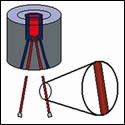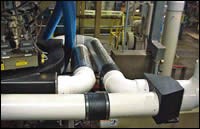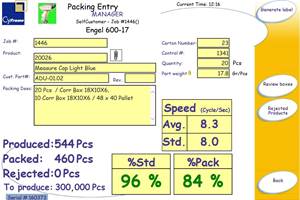Don't Let IBC Problems Burst Your Bubble
Under-blowing of air in internal bubble cooling (IBC) systems for blown film can cause the bubble to suck in or actually collapse.
Under-blowing of air in internal bubble cooling (IBC) systems for blown film can cause the bubble to suck in or actually collapse. Over-blowing can put too much air in the bubble, so that it bellows out until it catches on something like the sizing cage, where it can rip open and collapse. When a bubble comes down, it’s dramatic, but any IBC problem hurts output.
When operators troubleshoot poor IBC performance, they often focus on the control system. However, a good control system is more likely to cover up a problem than to be its cause. The controls monitor airflow either directly or indirectly, so when they detect reduced airflow, the system responds by increasing the appropriate blower speed. But controls can compensate only so far, and eventually reduced airflow starts to affect the bubble.
When we did a study of over 1000 IBC service incidents to see what actually caused production problems, we found that ducting failure ranked highest by more than two to one compared with the next most common cause. Yet ducting is probably the least thought-about component of an IBC system.
Intake ducting starts with the large main duct, which goes from the blower to the cooling coil, then to the flow control device (if there is one), and then to the distributor, which splits the airflow into a number of smaller pipes in a circle around the die. An 8-in. die may have three small intake and exhaust pipes, while an 80-in. die may have up to 24 larger ones.
Exhaust ducts follow exactly the same circuitry pattern in reverse, going from small ducts leaving the die back to a larger main exhaust duct and finally to the ex haust blower.
Causes of under-blowing
Under-blowing is typically caused by air intake duct problems. These include leaking joints and seams and over-use of flexible ducting, which can’t withstand high pressure and vacuum in the system and collapses. Leaking ducts and over-use of flexible hose are problems caused by choices made during the original installation.
If an HVAC contractor installed the ducting and used standard HVAC materials (which isn’t uncommon), the ducting won’t withstand the forces associated with an IBC. Typically, IBC ducting has to withstand static pressures and vacuum of up to 50 in. of water. Processors must specify the pressures and vacuums involved, as well as a water-tight installation.
The best choices are either PVC or preformed steel ducting with welded seams. Schedule 40 PVC is good for the intake supply run. The long, unsupported exhaust run may require Schedule 80 PVC, which can maintain rigidity under high temperatures. Flexible ducting should be limited to short, straight runs, where it may be needed to allow removal of the die cart for servicing.
It’s also good to put in Magnehelic static-pressure gauges (supplied by Dwyer Instruments, Michigan City, Ind.)—one for the intake air and one for the exhaust. These low-cost gauges provide highly visible indications of airflow. They make it easy to spot ducting problems because the static pressure at a known blower speed will change significantly.
Be sure to attach the exhaust gauge to the top of the duct. If it’s attached to the bottom, it will clog quickly from the exhaust residue. Some machine builders like to put their airflow-control device, which controls the layflat, inside the exhaust duct. But it’s likely to get gummed up in there. Better to put it in an intake air duct, where there are no polymer residues.
What causes over-blowing
Over-blowing happens when the exhaust ducts are constricted. Several things can cause this problem. Using the wrong exhaust hose—one that isn’t rigid enough—will cause it to collapse. Also, polymer residues accumulate inside exhaust ducting and cause blockage. Polyethylene resins can leave an oily residue, which cooks, then cools when the line shuts down, and builds up layers. This can plug ducts in a matter of months. Nylon and other high-heat engineering resins cause ducts to accumulate powders like white or colored snow. And reclaim accumulates residue faster than most virgin resins.
Accumulation of baked resin oils in the die exhaust pipes are the most difficult problem to avoid. The pipes inside the die are narrow, so they are more prone to clogging than larger ones, and also are hard to inspect.
Accumulation of residues can’t be completely avoided, but good ducting layout helps reduce the time required for cleaning. Poor installation causes ducts to plug. Bends from horizontal to vertical are prime locations for accumulations. Mitered elbows are even more prone to accumulate residue. These transitions should be placed off the floor, so it’s possible to install “grease traps” in the bend that allow residue to drain out of the main flow path of the duct.
Again, hold use of flexible ducting to an absolute minimum, and never use flexible ducting for 90° bends. Any duct that takes a right angle will plug easily, so it should be smooth inside and have a radius bend rather than a mitered bend. Some IBC systems can alert the operator when exhaust pipes need cleaning. But the best approach is to develop a schedule for preventive cleaning of exhaust pipes before they are so clogged that production rates suffer.
Flexible exhaust hoses on a conventional, multi-pipe spiral die are prone to failure because they connect to the bottom of the die, which is always hot. Even good-quality, expensive flexible hoses will fail eventually. A stack-type die brings IBC pipes straight up the middle of the die—one in, one out—and uses rigid pipe, so there are no flexible hoses to fail.
Daniel R. Joseph, P.E., is president and owner of D.R. Joseph Inc. in Grand Prairie, Texas, which specializes in parts and servicing for blown film production. He has developed and patented a number of commercial IBC technologies. He can be reached at (972) 641-7711, danielj@drjosephinc.com, and www.dr1.com.
Related Content
Part 2 Medical Tubing: Use Simulation to Troubleshoot, Optimize Processing & Dies
Simulation can determine whether a die has regions of low shear rate and shear stress on the metal surface where the polymer would ultimately degrade, and can help processors design dies better suited for their projects.
Read MoreUse Interactive Production Scheduling to Improve Your Plant's Efficiencies
When evaluating ERP solutions, consider the power of interactive production scheduling to effectively plan and allocate primary and secondary equipment, materials and resources on the overall production capacity of the business and conclude that this is a key area that cannot be overlooked.
Read MoreSingle vs. Twin-Screw Extruders: Why Mixing is Different
There have been many attempts to provide twin-screw-like mixing in singles, but except at very limited outputs none have been adequate. The odds of future success are long due to the inherent differences in the equipment types.
Read MoreReduce Downtime and Scrap in the Blown Film Industry
The blown film sector now benefits from a tailored solution developed by Chem-Trend to preserve integrity of the bubble.
Read MoreRead Next
People 4.0 – How to Get Buy-In from Your Staff for Industry 4.0 Systems
Implementing a production monitoring system as the foundation of a ‘smart factory’ is about integrating people with new technology as much as it is about integrating machines and computers. Here are tips from a company that has gone through the process.
Read MoreFor PLASTICS' CEO Seaholm, NPE to Shine Light on Sustainability Successes
With advocacy, communication and sustainability as three main pillars, Seaholm leads a trade association to NPE that ‘is more active today than we have ever been.’
Read MoreMaking the Circular Economy a Reality
Driven by brand owner demands and new worldwide legislation, the entire supply chain is working toward the shift to circularity, with some evidence the circular economy has already begun.
Read More
























